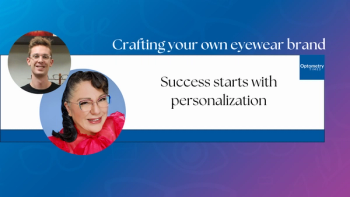
CCS 2025: Preparing optometric students for patient care and myopia management
Mark Bullimore, MCOptom, PhD, details the importance of preparing optometric students for myopic patient care in a Collaborative Care Symposium (CCS) 2025 presentation.
Mark Bullimore, MCOptom, PhD; Erin Tomiyama, OD, PhD; and Prethy Rao, MD, discussed the significance of myopia, emphasizing its role in uncorrectable visual impairment, particularly in the US. In an interview with the Eye Care Network, Bullimore highlighted various management options like atropine, orthokeratology, and soft contact lenses, noting limited spectacle options in the US. He stressed the importance of matching treatments to patients and ensuring adherence. Retinal issues such as ROP and lattice degeneration were also discussed, along with the need for laser therapy and anti-VEGF therapy for myopic maculopathy. Bullimore noted the evolution of myopia management in optometry programs and the necessity of educating patients and parents about the risks and management of myopia.
Video Transcript:
Editor's note: The below transcript has been lightly edited for clarity.
Mark Bullimore, MCOptom, PhD:
Hi. My name is Mark Bullimore, and I'm going to be presenting with Erin Tomiyama and Prethy Rao. Erin is a professor of optometry. Prethy is a retina specialist, ophthalmologist, and I'm sort of a card-carrying academic that doesn't see patients. So we're going to start by talking about why myopia is an issue and not just a refractive condition, really drilling down briefly on the role that myopia plays in uncorrectable visual impairment, and the fact that really in the US and other parts of the world, it accounts for over a third of all cases of uncorrectable visual impairment due to the complications associated with myopia. We're then led by Erin to talk about the various options available for managing myopia in terms of slowing its progression, so that obviously includes atropine, orthokeratology, soft contact lenses, and spectacles, although we have limited access in the US to spectacle options – like zero – and not quite so limited options to soft contact lenses. And then...some discussions about how to present it to patients, how long this is going to go on, when to stop. And given the fact that, particularly people north of the border in Canada, have a lot of options available to them, how do they choose among them? And we sort of emphasize the importance of matching the treatment to the patient and making sure that the patient is going to be [adherent]. And then finally, we're going to talk about retinal issues associated with myopia, things like ROP, lattice degeneration, and the importance of identifying a syndromic myopic patient, like a young child with stickler syndrome, and the extent to which laser therapy and anti-VEGF therapy can be applied to myopic maculopathy in the same way that [they] can be applied to macular degeneration.
How has myopia management changed in the academic space during your career?
I mean, certainly when I was in optometry school a little over 40 years ago, it was just about spectacles and contact lenses and, more recently, refractive surgery. And obviously, you're correct in the vision there, but we now understand the importance of slowing down, and even before that, delay in the onset of myopia. So if you look around optometry programs now, pretty much all of them have a myopia management clinic dedicated to managing these patients. Because one institution where I spent some time in the last decade, it didn't really exist, and the ortho-k was handled by the contact lens service. Other aspects were handled by the pediatric service. But what you're seeing in a lot more forward-thinking institutions is making sure that myopia management is in the curriculum, the didactic curriculum, and then there's a specific clinical experience so that students come out well equipped.
How do you best inform optometric students about the importance of patient care when it comes to myopia management?
I think that's one thing where we're still learning, because, you know, obviously, when I was training, and even 20 years ago, you would know about having a glaucoma talk with somebody, or the astigmatism talk, or the amblyopia talk with a patient and parent. We've had to develop our shtick, if you like, for myopia. And we're still learning. Throwing it into a patient's parent's lap, saying, 'Oh, you do realize that your child has myopia and this can lead to blindness.' That's not necessarily a winning strategy. And we're still learning, and I think the conversations we have with a parent who is myopic, particularly with a high level of myopia, it's relatively easy to talk about. We can envision a different future for your child than you've experienced. For a parent who's not myopic, I think the dialogue has to be slower and maybe continue over a month, matter of months, maybe even a year, so they get used to the idea. So I think making sure that our students and graduates are comfortable with those conversations, and that can only be taught, of course, if they have the experience during their training, either during the optometry program or during a residency. Now, I can't speak for how it's managed in ophthalmology. I would imagine that most of that would be deferred to a pediatric fellowship, but maybe Prethy can inform us on that.
What are some key takeaways you hope ECPs took away from your presentation?
Myopia, as stated by the recent National Academies report, should be considered a disease. It's not merely a refractive condition. It is a big source of uncorrectable visual impairment. And the risk of visual impairment is proportional to or related to the level of myopia. So delaying myopia onset, slowing its progression once it emerges, is an important thing for the future health of our patients. There are a number of options to both delay onset and slow progression, and that's a conversation that should be had. Later on, it's important that the myopic patient is aware of what might go wrong, both in terms of macular changes, but also retinal detachment, a higher risk of glaucoma, and that's something they need to be educated about on a course. Even if they go away and have SMILE or LASIK or some other refractive procedure, the risk remains.
Newsletter
Want more insights like this? Subscribe to Optometry Times and get clinical pearls and practice tips delivered straight to your inbox.
















































.png)


